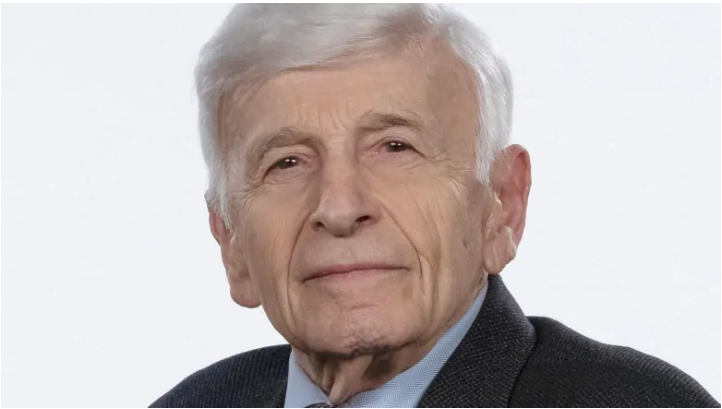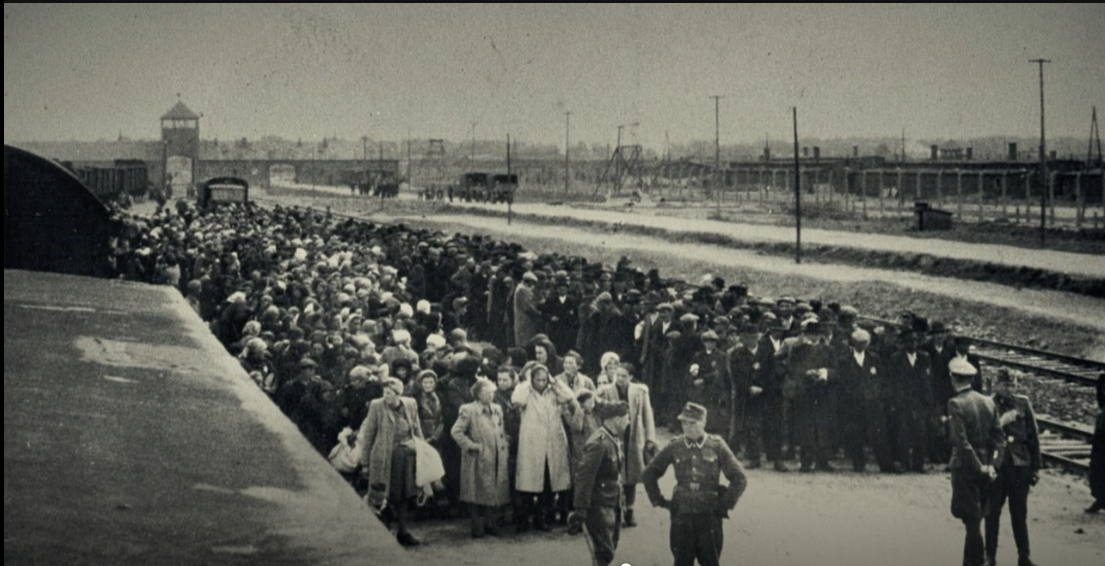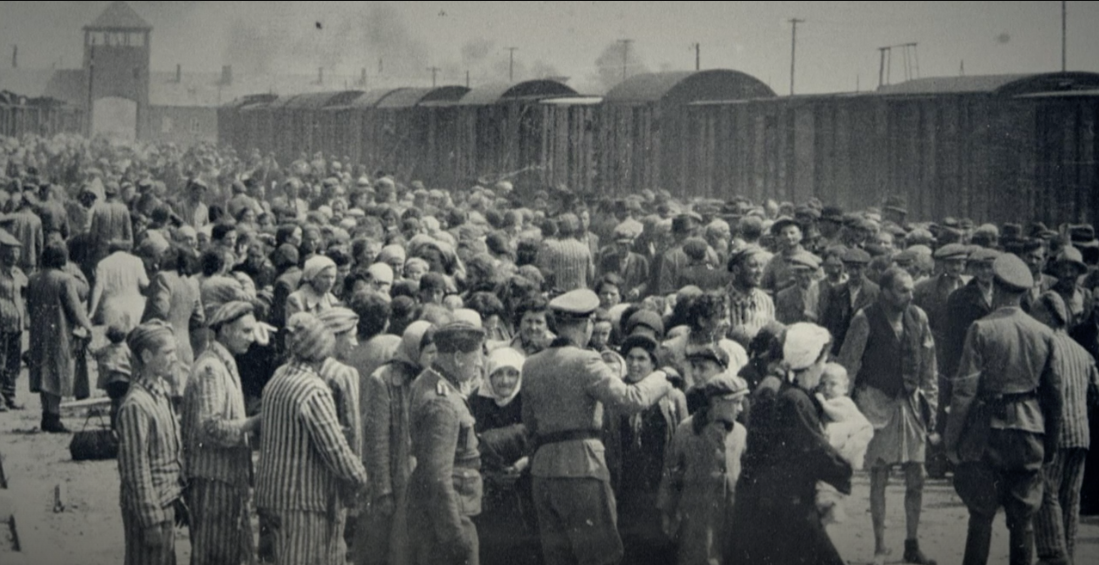Secrets of the Dead: Bombing Auschwitz is now streaming on, pbs.org/secrets and the PBS Video app to commemorate International Holocaust Remembrance Day and the 75th anniversary of the liberation of Auschwitz.
When author, educator and Holocaust survivor Max Eisen talks about his experience in Nazi-occupied Europe, he starts by remembering life before World War II. In a brief interview with Secrets of the Dead, He weaves between past and present tense, seemingly immersed in the memories of his childhood.
“I lived with my family, my paternal grandparents, my aunt and uncle, my parents, my two younger brothers, and my little sister in a large house –three families. They each have their own bedrooms, a kitchen. It was quite a lively place and there is a huge yard. My grandfather had a lumber yard on the premises, and a huge vegetable garden and an orchard with many, many beautiful plum trees. It was a very busy place. Chickens, geese and ducks were roaming all over the place.”
Eisen was born in Czechoslovakia in 1929 to an Orthodox Jewish family. Though Jews were a minority population in then-democratic Czechoslovakia (Eisen reckons Jews made up about ten percent of his rural town), he remembers a childhood rich with friendship, love and adventure.
“I had many friends, both Jewish and non-Jewish. We did not experience any antisemitism under the Czechoslovakian [government]. I went to a public school and Hebrew school. We had a one room, Hebrew school, a beautiful synagogue.”
However, Eisen’s childhood ended early after French and British leaders agreed to surrender Czechoslovakia to Nazi Germany in 1938. In his 2016 memoir, By Chance Alone: A Remarkable True Story of Courage and Survival at Auschwitz, Eisen writes that after the annexation, “The Czechoslovakian Jewish population was left with a deep sense of dread.”
After a barrage of restrictive sanctions on Jewish people in Nazi territory, Eisen’s father lost his business –a distillery– and was deported to work in mines, forests, and military installations on the Eastern Front along with his uncle and grandfather. Shortly after, in 1942, Eisen and the rest of his family learned they too would be deported. They were rounded up and put on a cattle train heading toward Nazi-occupied Ukraine. Eisen hid his mother’s money in the lining of his boots to avoid confiscation by the Kommandant. During the days-long journey, Eisen recalled seeing the names of families scribbled on the walls of the cattle cars.
“Families who went before us had written their names on the wooden planks that formed the wall of the shed. Each person’s family name was written down, along with the day of their departure and the name of their destination—Kamenets-Podolsky. Thousands of names from previous transports were scribbled on the walls. Each one was like a life marker, a statement to remind the world that these people had lived.”
Though their destination was scribbles on the walls of their cattle car, Eisen, his family, and the rest of the people on the train could not be sure where they were headed. Eisen later found out, years later, that the train was headed for Kamenets-Podolsky in Nazi-occupied Ukraine –the site of the first large-scale mass murder of the Holocaust. But, on the last leg of the journey, the Kommandant announced that their train would not be going to its final destination, and all the families aboard could go back home.
Historically, this was the result of political disagreement within the Hungarian government, but Eisen chillingly notes that the train he and his family took to Ukraine was the last of the trains that transported thousands of Jews to their deaths at the hands of the Einsatzgruppen, the Nazis’ mobile killing units.
Though Eisen eventually made it back home with his family, he returned to life in his hometown as a second-class citizen; he was forced to leave school due to the cruelty of his teachers and the trauma of being deported. At 13 years old, he began an apprenticeship at a fur shop in a nearby town and stayed there for two years.
In the spring of 1944, Eisen and his family came together for Passover. In the middle of the night, an man from the town came to the family’s home to warn them that Nazi forces would soon be rounding up Jewish families for deportation. The man offered to hide Eisen’s family, but his grandfather refused. The next day, all 90 Jewish families in the town were removed from their homes and taken to a nearby schoolhouse, where they spent the night in confusion and fear.
“We were only a twenty-or twenty-five-minute walk from our homes and the comfort of our beds, but instead we were sitting on the floor of the school. We began to realize that we were no longer the masters of our own destiny. ”
Eventually, all the families in the schoolhouse were transported –again, via locomotive cattle cars– to Auschwitz II-Birkenau. The SS soldiers organizing the deportation refused passengers food and water, and several people died on the days-long journey. Eisen remembers the camp’s guards separating women and children from the men –and the distinct smell of burning flesh coming from what would later be discovered as perhaps the most nefarious killing instrument of the Holocaust: the Auschwitz gas chambers. Eisen’s mother, baby sister and grandmother were unceremoniously gassed and cremated in the chambers before the rest of his family even knew where they had gone.
Eisen, along with his father and uncle were sent to Auschwitz I to work as laborers. They worked under inhumane conditions alongside hundreds of other prisoners. Eisen witnessed violence, malnutrition and death on a daily basis. In July 1944, The barracks where Eisen, his father and his uncle slept were raided by SS guards. The two older men were taken to the gas chambers to be executed. They had only moments to say goodbye but Eisen’s father blessed him with a traditional Jewish prayer and made him promise to tell the story of what had happened at Auschwitz if he made it out alive.
“Through the wire [fence] my father gave me his blessing. He told me that if I managed to survive, I’d have to tell the world what happened there.”
Eisen kept his promise, though he almost died in the camp. In this excerpt from his memoir, he recalls being brutally beaten by a guard to the point where he got a serious head injury. Miraculously, he was saved by Dr. Orzeszko –a Polish prisoner who was put to work treating other prisoners.
“It was a well-known fact among the prisoners that unless a door opened for you, it was impossible to get out of Auschwitz alive. My head wound was, ironically, exactly the door that I needed. It had saved me from the rigorous work on the Landwirtschaft Kommando. But even that opportunity would not have been possible without the immediate first aid I received from Under-Kapo Stasek, who stopped the bleeding and arranged for my delivery to the surgery in barrack 21. Without his initiative, my story would have ended in that scrubby field of tree stumps. I also owed my life to Dr. Orzeszko, who not only operated on my wound but also took me off the stretcher before I was sent to the gas chamber in Birkenau.
I worked in the operating room for six months, and my structured daily routines allowed me to survive away from the severe hard labor and the threat of the SS guards and the Kapos. Dr. Orzeszko was a dedicated and skillful surgeon who was respected by his peers and the Polish political prisoners of Auschwitz I. I suspected that he also played an integral role in the Polish underground in the camp, a fact that was later confirmed by his family.
A short while after I started working in the operating room, Dr. Orzeszko opened a pantry door and showed me shelves loaded with food supplies, including loaves of bread, salami, onions, potatoes, carrots, salt and pepper, and a large cooking pot. I was astounded at this bonanza—more food than I’d seen since I left my home in April 1944. He told me how to prepare a stew with all the provisions, and how to use the autoclave as a pressure cooker. I salivated at the scent of the cooking food. Of course, there was always the worry that the aroma would give us away, so this activity was done after all the operations were finished and the SS officer in charge of the barracks had left for the night. The meal was ready in less than an hour, and in no time I felt that my stomach was so full it might burst. I couldn’t believe that I’d just had a bowl of goulash in Auschwitz! The leftovers were locked in the pantry and consumed the next day. The ingredients for our stews were sent by the chief cook, and I knew that I was one of the privileged few who had access to such provisions. The extra calories made a huge difference in my overall health and stamina, and this nourishment was key to my survival.
Dr. Orzeszko, like other Polish political prisoners, was allowed to receive small monthly care packages containing food and other supplies. He was also allowed to receive and write one letter per month. When the doctor’s package was delivered to the operating room, he would open it with tremendous care, as if wanting to feel the love from his family members back home. I was happy for him, but it only reinforced the fact that Jewish inmates didn’t have this same privilege. There was no one left to send us these precious gifts.” – Excerpt from By Chance Alone: A Remarkable True Story of Courage and Survival at Auschwitz by Max Eisen
Before Auschwitz was liberated on January 27, 1945, Eisen was sent on a 13-day death march from Auschwitz to Loslau, another still Nazi-occupied town in southern Poland. Thousands of prisoners died on the march, but on May 6, 1945, Eisen was liberated by the United States’ 761st Tank Battalion, a unit of primarily African American soldiers known as the Black Panthers. Eisen was 16 years old.
After nearly five years of physical and emotional recovery, Eisen emigrated to Canada in 1949, where he has lived ever since. He considers Holocaust survivor stories like his vital in terms of education and understanding the evolution of hate.
“If we do not understand the history of hate, we cannot recognize the ideology that brings about violence.”
Parts of Max Eisen’s story are featured in Secrets of the Dead: Bombing Auschwitz. Learn more about Eisen’s life, and his testimony at the trials of former Auschwitz guards in his memoir By Chance Alone: A Remarkable True Story of Courage and Survival at Auschwitz.
Note: Portions of Eisen’s interview with Secrets of the Dead have been edited for length and clarity. Excerpts from Eisen’s memoir are denoted in italics.



